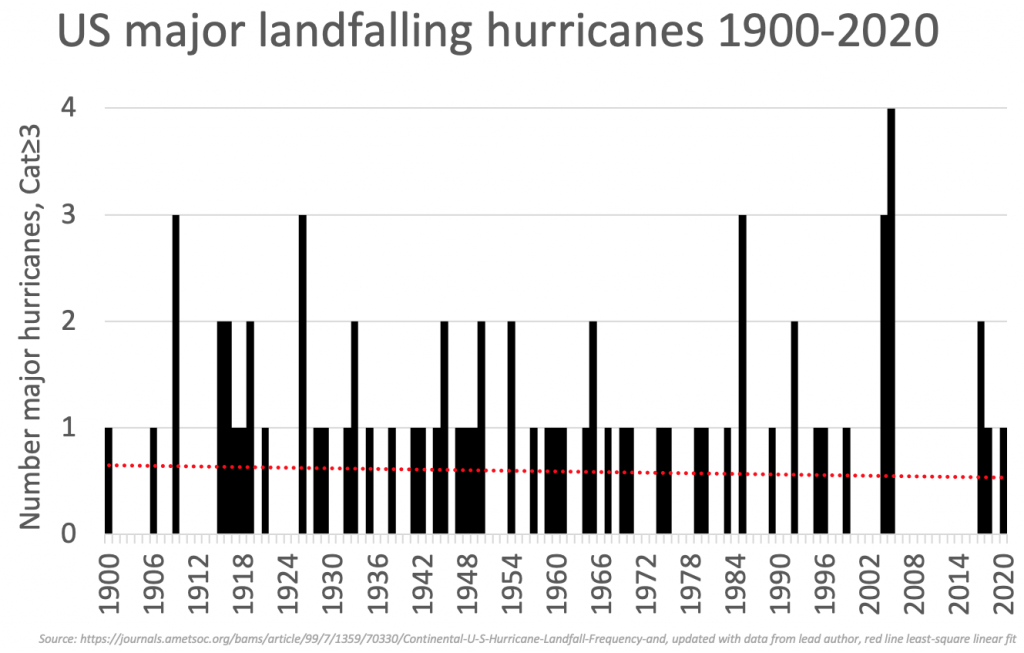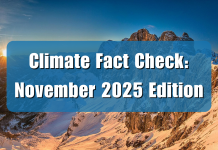Among its top search results today for “climate change,” Google News is highlighting an article from Defense News titled, “Battling climate change starts with military action.” The article falsely claims climate change is threatening U.S. military operations and preparedness by enhancing sea level rise and extreme weather events. Both claims are untrue. Data from the United Nations Intergovernmental Panel on Climate Change (IPCC) and from the U.S. National Oceanic and Atmospheric Administration (NOAA) consistently show the number and intensity of extreme weather events, from hurricanes to wildfires are about the same, or even slightly less frequent and severe, than they have been historically.
Cmdr. Benjamin Simon writes:
“The effects of climate change are all around. They can be seen by the Gulf Coast bracing for seven named storms in 2020; wildfires in California interrupting electricity for hundreds of thousands ….
As a 16-year naval aviator, I have seen how serious climate instability is: From the flooding of our naval bases, due to the rising sea level, to increased storms at a higher intensity, the climate emergency is affecting our military’s capability to operate. During my service, I had to cancel missions due to hurricanes, typhoons and other severe weather.”
It is almost certainly true that during his career as a naval aviator Simon has had to cancel missions due to extreme weather. He has also likely seen military bases flood on occasion. However, hurricanes and flooding are historically common natural occurrences, long pre-dating the current obsession with climate change. Also the best available evidence indicates such extremes are not becoming more common, nor is the current rate of sea level rise exceeding historic rates.
As discussed in Climate Realism here, here, and here, for example, 2020 did not a set a record for hurricanes in the United States, and hurricane numbers and intensity have been in a long-term decline (See the figure below).

Simon presents no evidence California’s 2020 wildfire season disrupted any military operations. However, even if it did, as discussed here and here, for example, there is copious evidence wildfires across the Western United States have been in a long-term decline. Also historically, California has experienced wildfire seasons as bad as, or worse than, 2020’s on a nearly annual basis.
Sea levels are rising. However, as detailed in Climate at a Glance: Sea Level Rise: Data shows global sea level has been rising at a relatively steady pace of approximately one foot per century since at least the mid-1800s, which was long before coal power plants and SUVs. Moreover, the United Nations Intergovernmental Panel on Climate Change (IPCC) confirms here has been no significant recent acceleration.
Global sea level has risen approximately 400 feet since the beginning of the end of the most recent ice age—approximately 20,000 years ago. The rate of sea level rise has risen and fallen at various times since then, slowing and increasing on the order of tens, hundreds, and thousands of years over the past 20,000 years. None of this variance had anything to do with human activities. Indeed, as NASA reports, sea level always rises between ice ages as ice sheets retreat. During the last interglacial period between ice ages, seas were four to six meters higher than we are experiencing today.
As shown in Climate Realism recent claims made by climate alarmists that sea level rise has been accelerating is due to scientists combining the two dissimilar data sets from different sets of satellites, neither of which shows accelerated sea level rise. They then plotted a new trend showing acceleration. As meteorologist Anthony Watts writes concerning this manipulation of the data, “This is either incompetent or dishonest, and certainly not up to even the simplest of basic science principles.”
Recent flooding at naval stations, as is true for many cities around the world, is due more to land subsidence—the gradual sinking of land either under its own weight, under the weight of manmade structures, due to water withdrawals from aquifers, and from the conversion and replacement of wetlands with infrastructure—rather than from sea levels rising at an increasing rate. As noted in a report by the National Center for Public Policy Research:
In a 2010 report submitted to the U.S. Army Corps of Engineers, the Virginia Institute of Marine Science found that 50 percent of the relative sea-level rise at Chesapeake Bay water-level stations between 1976 and 2007 was due to subsidence. At Norfolk and other bases subject to subsidence, it’s not just the seas that are rising, but the land that’s sinking.
In order for climate change to be hampering U.S. military operations and preparedness, it must first be causing more frequent or severe weather events or making seas rise faster. Data demonstrates it is not, and Google News and Defense News should know this.























